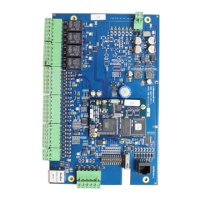Honeywell
• Specify the Status, Egress and Tamper Debounce time, or the period of time when
the input must remain in new state before it is recognized.
• Specify the time zones for the Status, Egress and Tamper inputs.
• Enable or disable Auto-Relock for the Status input.
Refer to the table below to configure Status, Egress and Tamper inputs.
Table 5-5 Input Settings Description
Setting Description
Name A unique name identifies the device.
Mode
Normally Closed - Means that the door’s normal state is closed.
Normally Open - Means that the door’s normal state is open.
Unsupervised - Means that the door’s electrical circuit is wired in one path
without alternative paths supervised by resistors.
Supervised - Means that the door’s electrical circuit is wired with alternative
paths supervised by resistors.
Shunt Time
Specifies the amount of time for which the inputs will be shunted, or de-
activated. For example, it specifies how long a door strike will remain
released. Enter the desired number of hours (1024 maximum), minutes (60
maximum), and seconds (60 maximum). The sum of all three units
comprises the shunt time. Note that you can express seconds in tenths of a
second.
Debounce
Time
Specifies the period of time the input must remain in a new state before
generating an alarm. For example, if a Normal state is changed to Alarm,
the state must remain in Alarm for five seconds before an alarm is
generated.
Time Zones
Shunt - Specifies the time period during which the input will be ignored.
Disable Interlock - Specifies the time period during which the programmed
action on this input from another point will be disabled.
Disable Alarm msgs - Specifies the time period during which the input will
generate no alarms.
Auto-Relock
Causes the door to relock immediately when the door status switch closes
after entry. The output relay that controls the door strike de-energizes when
the associated input returns to normal state instead of remaining energized
for the duration of the pulse time. To enable Auto-Relock, select the Enable
checkbox.
Click【Update】to submit changes.
Output Settings
An output, or output relay, is a switch on the panel that either energizes or de-energizes
or pulses an output device, such as a door lock or a horn. For example, a successful
card read at a reader (input device) causes the output relay switch on the panel board to
change the normal state of a door lock (output device), so that the normally-locked door
strike releases and permits entry.
31

